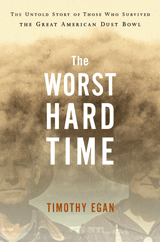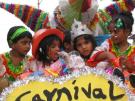 What do you think of when you hear the phrase, "Dust Bowl"? Like most people, I learned about the Dust Bowl in my high school history class. But even though I attended high school last century (iieee!), as I recall, my textbook devoted perhaps one paragraph to this event before moving on to other, more important events, such as the stock market crash and the banking failure, the Great Depression, Roosevelt's New Deal, and World War II. In fact, except for my astonished sadness after reading John Steinbeck's literary rant, The Grapes of Wrath, I never gave the actual event much thought. However, I recently discovered this overlooked chapter of American history in Timothy Egan's latest book, The Worst Hard Time: The Untold Story of Those Who Survived the Great American Dust Bowl (NYC: Houghton Mifflin, 2006).
What do you think of when you hear the phrase, "Dust Bowl"? Like most people, I learned about the Dust Bowl in my high school history class. But even though I attended high school last century (iieee!), as I recall, my textbook devoted perhaps one paragraph to this event before moving on to other, more important events, such as the stock market crash and the banking failure, the Great Depression, Roosevelt's New Deal, and World War II. In fact, except for my astonished sadness after reading John Steinbeck's literary rant, The Grapes of Wrath, I never gave the actual event much thought. However, I recently discovered this overlooked chapter of American history in Timothy Egan's latest book, The Worst Hard Time: The Untold Story of Those Who Survived the Great American Dust Bowl (NYC: Houghton Mifflin, 2006).
Egan's meticulously researched book tells the compelling and tragic stories of the settlers who lived through the Dust Bowl era in the south-central plains of North America, an area including the flat lands of Colorado, Nebraska, Kansas, New Mexico and "No Man's Land" located in the heart of the Dust Bowl; the panhandles of Texas and Oklahoma.
The book begins in 1901, twenty-five years after Texans had thumbed their collective noses at the United States government by refusing to honor signed treaties with the Plains Indians. In 1875, shortly after defeating and corralling the last of those pesky Comanche, General Sheridan told the Texas legislature that, for the sake of a lasting peace, the Anglos should "kill, skin and sell until the buffaloes are exterminated. Then your prairie can be covered with speckled cattle and the festive cowboy .. the forerunner of an advanced civilization."
Enthusiastically heeding this grim war cry, bloodthirsty Anglos invaded the plains and, within ten years, killed approximately 25 million animals whose herds covered fifty square miles of open grassland, leaving their skinned bodies to rot, leaving behind a hundred million acres of empty, windswept prairie under an endless, cloudless sky. Leaving the federal government to rhetorically ask, What shall we do with all this unoccupied land? As you know, it didn't take long for the government to formulate a plan of action.
Thus began "The Great Plowup"; an era of tremendous success for the nesters and the sodbusters who settled and tamed the prairie by replacing that vast sea of hardy buffalo grasses with thirsty crops of wheat and corn. Since these were unusually wet years on the Great Plains, both crops and towns grew and farmers became rich, first purchasing expensive farm equipment, then luxuries such as pianos and designer clothing from France.
But this era ended with the stock market crash of 1929, followed by an intense decade-long drought. This drought was so severe that as little as ten inches of rain fell in a single year and soil temperatures soared to as high as 141 degrees. Grasshopper, tarantula, black widow and centipede populations exploded in the dry heat. Ever-present winds ripped naked topsoil from the earth and carried it thousands of miles away, dropping it onto Chicago, New York City and Washington DC, even coating ships several miles off the coast along the northeastern seaboard. A quarter million people fled the resulting dust storms in the 1930s.
But, astonishingly, most people stayed put. Why? To answer this question, Egan introduces us to an amazing cast of survivors including Bam White, an Anglo-Apache/Cherokee cowboy who was reviled by his neighbors after appearing behind a plow in the movie, The Plow that Broke the Plains; Hazel Lucas Shaw, a teen-aged bride whose infant daughter and grandmother died on the same day from "dust pneumonia"; Hugh Bennett, who helped "heal" the Great Plains for the Roosevelt Administration and became one of the heros of the New Deal; Don Hartwell, whose difficult times were faithfully recorded in his diary and subsequently quoted in Egan's book; Gustav Borth, who hid behind his shed so his family would not see him weeping over debts he couldn't pay; Caroline Henderson, who dreamt of rain but always awoke to "another day of wind and dust and hopes deferred." Egan's powerful prose transports the reader back in time, and we are welcomed as friends into once-vibrant prairie towns such as Boise City and Dalhart and Inavale.
Throughout his book, Egan focuses on the land and the people, providing photographs and just enough statistics such that the reader can understand the devastation that they endured. We are outraged at these farmers' betrayal when the banks failed after stealing their hard-earned savings, thereby driving them to tear up even more sod for cash-giving crops; we watch their agonizing struggles as the drought escalates and precious topsoil dries up and blows away; we despair alongside them when the land appears to be recovering, just a little bit, only to have grasshoppers descend with voracious gusto upon tender young crops, wood fences and even the clothes on their very backs. As the remaining unread pages in the book thin out, you might wonder; How does this disaster end?
Today, some of this scarred land still drifts aimlessly on persistent winds, having never recovered. Today, those "healed" portions of the Great Plains are primarily under the control of agribusinesses that suck 15,000 year-old glacial meltwater out of the Ogallala Aquifer to satisfy thirsty crops -- an aquifer that is predicted to run completely dry in 100 years or less. Which leads me to ask; after all this suffering, after this enormous devastation, have we learned nothing at all? Today, as we face the looming effects of widespread environmental damages and global warming, I wonder; is this nation doomed to mindlessly repeat our failures .. forever?
Egan provides no answers to these crucial questions, but he does provide plenty to think about in his passionate but reasoned account of the Dust Bowl days. I highly recommend this fascinating but sad tale about the greatest environmental disaster in the history of this nation, and hope that it will serve as a stern warning about the very real consequences of human ignorance, greed and hubris.
Timothy Egan is a journalist who writes for the New York Times. He has published four books and has won several awards, including the Pulitzer Prize. He lives with his family in Seattle.
Included with "The Best Science, Nature and Medical Blog Writing" by The Tangled Bank,
Issue #53.
Included in the Carnival of Education, week 65.
Included in the Carnival of the Vanities,
Dodgeblogium style.
Also included in the Carnival of the Green,
number 26.
And, last but not least, this essay was also included in a new carnival (for me), The History Carnival,
issue 31.


Hey you're good. Another well written review. Thanks
Bob
Nice review. I just finished reading it, and travelling the Great Plains, and you really captured the spirit of the book. Before reading the book I hadn't realized how close to collapse the country was during those years.
BTW, "The Plow that Broke the Plains", the movie mentioned in the book is online at http://www.archive.org/details/PlowThatBrokethePlains1
The Dust Bowl is a very sobering event because it reveals the extent to which humans have harmed the environment and the potential for future disasters. With the changes in agricultural practices, I expect that we will see more of these in the future.
Another good (and short) book on the subject is Donald Worster's Dust Bowl.
Thanks, Bob. I only ask for books to review that I am reasonably certain to like.
Thanks for that link, Joe. I hadn't thought to look for that movie on the web. like, duh!
And thanks for the link to Worster's book, John.
I am sure my readers will be interested to check those links out.
My opinion to answer your question is "Yes, we are doomed to repeat our mistakes as long as the dollar is put before the environment."
Good review.
Thanks for the review. Earthwatch radio did a series of short interviews with the author a few weeks ago. It's great to get a more complete perspective on the book. I'll have to add it my wishlist.
I look forward to reading the book, being from that part of the world myself. There's a really good video from PBS entitled Surviving the Dust Bowl that has an interview of Bam White's son and mentions several of the other people in your review.
I just got a book today entitled American Outback: The Oklahome Panhandle in the Twentieth Century, by Richard Lowitt. I can't wait to read it.
This is a very well-written review. My great-grandmother was Hazel Lucas Shaw, and the publicity of this book will help spread her story. Thank you.